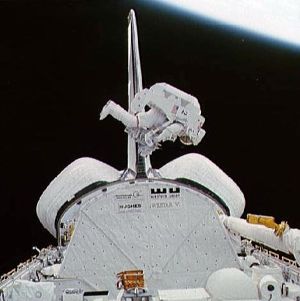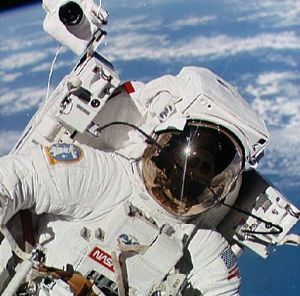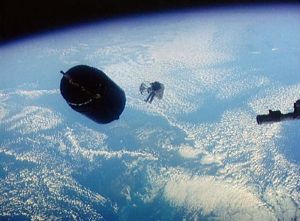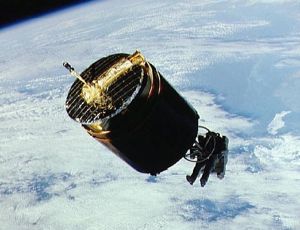
Home - Search - Browse - Alphabetic Index: 0- 1- 2- 3- 4- 5- 6- 7- 8- 9
A- B- C- D- E- F- G- H- I- J- K- L- M- N- O- P- Q- R- S- T- U- V- W- X- Y- Z
Shuttle MMU

STS-41-B
View of Astronaut Bruce McCandless during EVA
Credit: NASA
Status: tested 1984. First Launch: 1984-02-03. Last Launch: 1984-04-06. Number: 4 . Gross mass: 140 kg (300 lb).
After the shuttle disaster, use of the unit was discontinued on safety grounds.
The MMU was a one-man, nitrogen-propelled backpack that latched to the Shuttle EMU spacesuit's PLSS life support system. Using rotational and translational hand controllers, the crewmember could fly with precision in or around the orbiter cargo bay or to nearby free-flying payloads or structures, and could reach many otherwise inaccessible areas outside the orbiter. Astronauts wearing MMU's deployed, serviced, repaired, and retrieved satellite payloads.
The MMU propellant - non-contaminating gaseous nitrogen stored under high pressure - could be recharged from the orbiter. The reliability of the unit was guaranteed with a dual parallel system rather than a backup redundant system. In the event of a failure in one parallel system, the system would be shut down and the remaining system would be used to return the MMU to the orbiter cargo bay. The MMU, which weighed 140 kg, included a 35-mm still photo camera that was operated by the astronaut while working in space.
Family: Space Suits. Country: USA. Launch Vehicles: Space Shuttle. Launch Sites: Cape Canaveral LC39A. Agency: NASA. Bibliography: 489.
 | STS-41-B View of Astronaut Bruce McCandless during EVA Credit: NASA |
 | STS-41-B Close-up view of Astronaut McCandless during his EVA Credit: NASA |
 | STS-41-C View of Astronaut Nelson using MMU to examine Solar Maximum Mission Satellite Credit: NASA |
 | STS-51-A Astronaut Dale Gardner using MMU to travel to Westar VI satellite Credit: NASA |
 | STS-51-A Astronaut Dale Gardner using MMU to travel to Westar VI satellite Credit: NASA |
 | STS-51-A Astronaut Dale Gardner using MMU to travel to Westar VI satellite Credit: NASA |
1984 February 3 - . 13:00 GMT - . Launch Site: Cape Canaveral. Launch Complex: Cape Canaveral LC39A. Launch Platform: MLP2. LV Family: Shuttle. Launch Vehicle: Space Shuttle.
- MMU 3 - . Nation: USA. Agency: NASA. Program: STS. Spacecraft: Shuttle MMU. COSPAR: 1984-011xx.
- MMU 2 - . Nation: USA. Agency: NASA. Program: STS. Spacecraft: Shuttle MMU. COSPAR: 1984-011xx.
1984 April 6 - . 13:58 GMT - . Launch Site: Cape Canaveral. Launch Complex: Cape Canaveral LC39A. Launch Platform: MLP1. LV Family: Shuttle. Launch Vehicle: Space Shuttle.
- MMU 2 - . Nation: USA. Agency: NASA. Program: STS. Spacecraft: Shuttle MMU. Decay Date: 1984-04-13 . USAF Sat Cat: 14897 . COSPAR: 1984-034xx. Apogee: 496 km (308 mi). Perigee: 494 km (306 mi). Inclination: 28.50 deg. Period: 94.50 min.
- MMU 3 - . Nation: USA. Agency: NASA. Program: STS. Spacecraft: Shuttle MMU. Decay Date: 1984-04-13 . USAF Sat Cat: 14897 . COSPAR: 1984-034xx. Apogee: 496 km (308 mi). Perigee: 494 km (306 mi). Inclination: 28.50 deg. Period: 94.50 min.
Back to top of page
Home - Search - Browse - Alphabetic Index: 0- 1- 2- 3- 4- 5- 6- 7- 8- 9
A- B- C- D- E- F- G- H- I- J- K- L- M- N- O- P- Q- R- S- T- U- V- W- X- Y- Z
© 1997-2019 Mark Wade - Contact
© / Conditions for Use